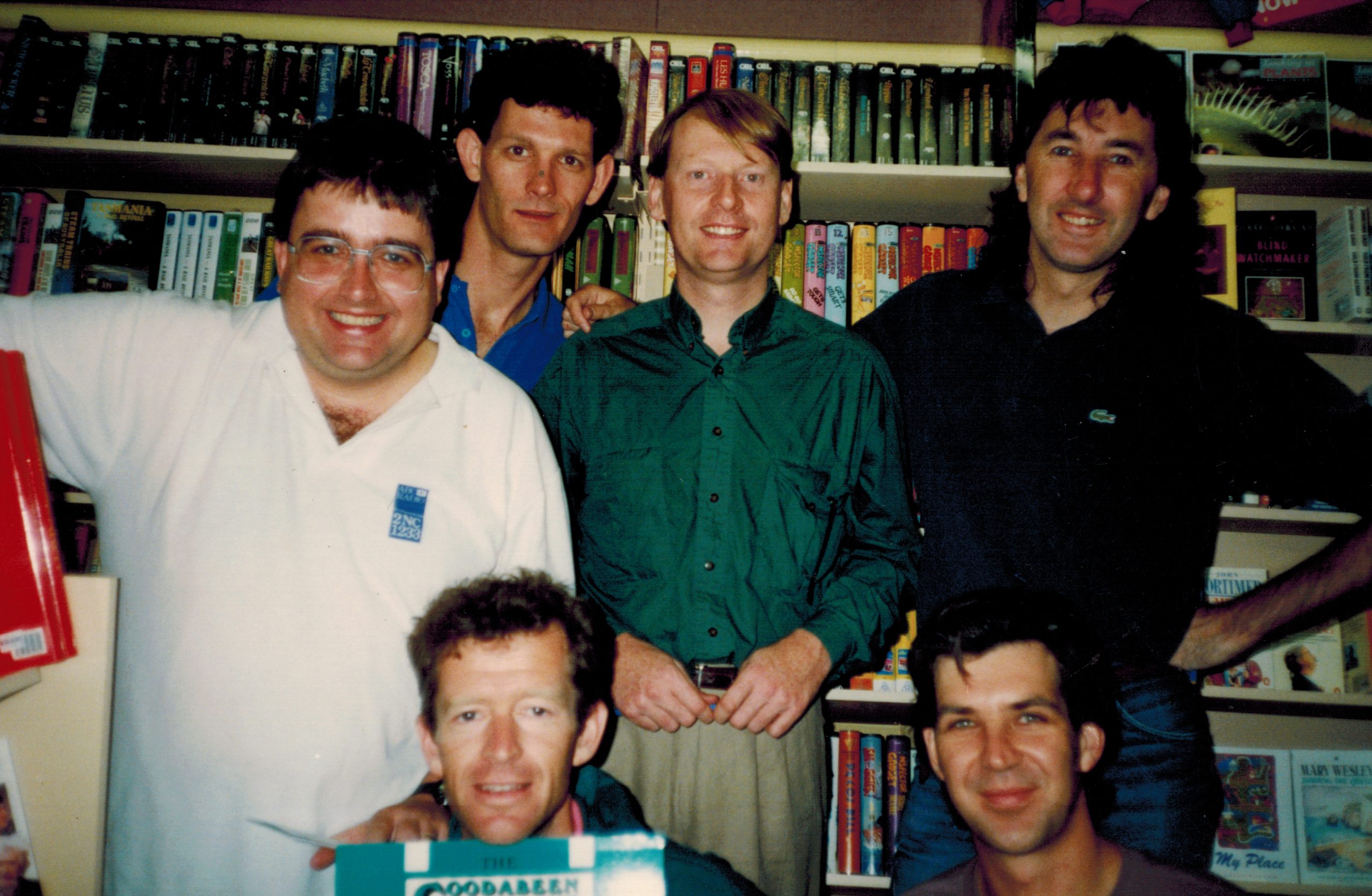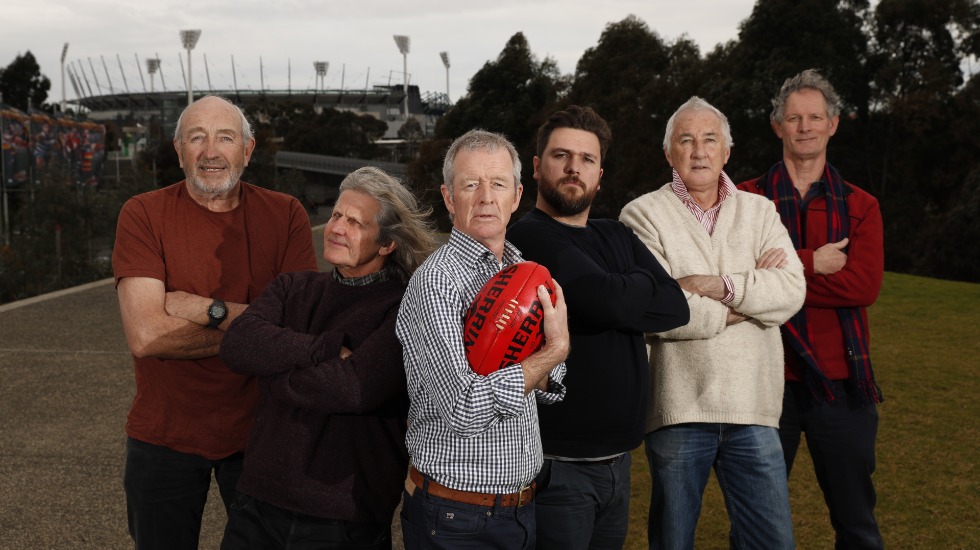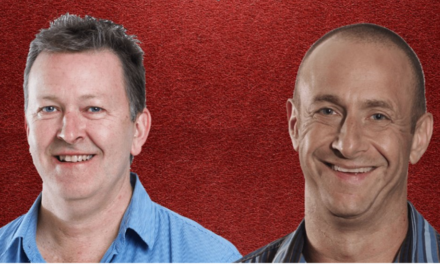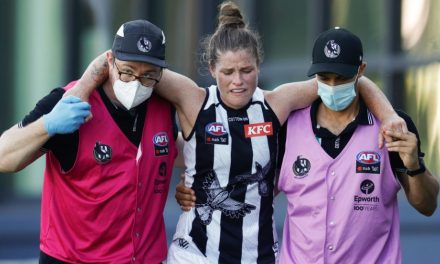“Coodabeen Champions” (from left): ‘Torch’ McGee, Billy Baxter, Ian Cover, Andy Bellairs, Jeff Richardson and Greg Champion.
When Ennio Morricone recently passed away, original “Coodabeen Champion” Euan Keddie explained why back in 1981 he suggested “The Good, the Bad and the Ugly” as the theme song for their new ramshackle radio show. Keddie thought the tune made you feel like you were about to rob a stagecoach.
Whether by design or by accident, the “Coodabeen Champions” have now spent 40 seasons robbing the footy’s stagecoach – in the NPW (Nicest Possible Way).
2020 was set-up as a victory lap year for the Coodabeens with the return of founding member Simon Whelan and 40th birthday celebrations, but no footy for a long stretch may have put it all on hold for mere mortals.
Though to doubt would underestimate the abilities of the group that proudly eschew any serious footy talk – the presence of the Coodabeens in 2020 has been a comfort for the times.
And now there’s a bonus for fans with the release of a book celebrating those 40 years.
Ian Cover was there during season one in 1981, and says the idea for the book had been around for a few years. The 40th year was the obvious milestone to put it all on the record, even if it was just for the group themselves to look back on. But the process of how it came together is as organic as the show itself.
“Last year, I hosted a launch for cartoonist Paul Harvey’s book, and got chatting to his publisher Michael Wilkinson about this idea that had been kicking around, and 12 months later here we are,” Cover says.
The format was up for debate, though .“Years ago, Simon had an idea that we should all write our own versions of how we started without telling the others, and then the reader would have to work out which was nearest to the truth!
“But eventually we decided we just needed to all get in a room, hit record and tell the story. We then got it transcribed with the intention of writing it in the traditional manner, but the publisher got hold of the transcriptions, and said: ‘This is perfect – the readers know the voices, and will hear this play out like they were listening to the show on a Saturday morning’.”
“It saved me a lot of work!”
They last released a book in 1990. “As far as books are concerned, we’re taking it 30 years at a time,” Cover quips in typical Coodabeen fashion.
The story of a couple of mates who decided to take their footy talk to community radio as a weekend lark gets the definitive explanation, but that refrain of “40 years without a plan” is one that should be taken with an understanding that there is a modesty to the Coodabeens that underplays what they did and continue to do.
Radio 3RRR was, and is, the place where Melbourne’s most creative find their voice, and the early ‘80s was a fertile time.
The Coodabeens’ Saturday morning slot nestled next to other seminal programs like “Punter to Punter” and “Lawyers, Guns and Money” during the era, spawning mainstream and cult favourites like Ross Stevenson, Dr. Turf, Slim Whittle and Trevor Marmalade.
The story of how the core Coodabeens serendipitously found each other through various friends of friends who passed by those 3RRR studious will warm their fans hearts. “We think there’s been about 50 Coodabeens across the years, most in those early days”, Cover says.
It was a sprawling collective, and radically for the time, it even had women talking about football, Helen Molnar driving its “Academic Think Tank” segment for many years.
Footy historian Rhett Bartlett recently digitised some tapes of the show’s formative years, which are a fascinating listen for a snapshot of the show and the broader era.
Performed pieces and radio play serials were absurdist but perceptive, like Simon Whelan’s “Lindsay Airport” character, which typified the group’s scepticism of the corporatisation of the game.
“Lindsay Airport was one of Simon’s great creations that told the future of footy, really, and we later brought him to life for TV,” Cover says.
Satire, academia, music and performance art were not staples of the footy media offering of the time, but those inner-city staples combined with the voice of the outer saw a cult grow.
The celebration of the ordinary and obscure became an aesthetic by their name and nature, as Cover confirms. “There’s a lot of ingredients that go into the cake, but a lot of the focus is on the icing. We liked talking about the crumbs sometimes.”
Who would remember 68-game journeyman Gary Frangalas, if not for the Coodabeens?
“To do a song that says: ‘Who’s the player who’s most respected, who’s the player who’s first selected’ – you wonder which champion it’s going to be, and then it’s Gary Frangalas! So you get a laugh out of it, but you also made him a name.”
And there were no hard feelings, “His fiancée got in touch with ‘Champs’ (singer/songwriter Greg Champion) for a copy of the song to play as their wedding dance!”
There’s a bit of a romanticism that Melbourne is the place where the artist and the sporting jock crossover – it hasn’t always, and the Coodabeens bridged those cultures. But Cover says it wasn’t a deliberate plan to take an alternative path.
“We never sat back and analysed any of these things along the way, so it kind of just happened,” he says.
“Clearly, Jeff (Richardson) and Simon identified that the voice of the fan was missing and that’s what drove them to start it, but there wasn’t a thought that: ‘We’ll bring down VFL House’. It was just being clever and having a laugh like that funny bloke in the outer. Back then as it is now, a lot of people inside the game never seemed to reflect the enjoyment of being involved in it enough, so we wanted to have fun.”
“But it certainly was anti-establishment in those early days.”
The true spirit of the group can be seen when it was handed the keys to host Channel 7’s all-night footy marathon in 1986. The story of that night is required reading by Richard Prentice on “The Footy Almanac”, and is reprinted in the book, and gloriously, the YouTube clips live on.
The five principal members at the time of Whelan, Richardson, Cover, Tony Leonard and Greg Champion gently mocked footy greats, filmed bizarre skits with the aforementioned “Lindsay Airport” in-between playing legendary finals matches. All the while a party went on around them that gathered in numbers through the night, perfectly emblematic of their rise.
The show was now a crossover success, and eventually the ABC lured them to the big time. The talkback segment became its calling card, satirising footy radio and spawning characters and catchcries that entered the footy lexicon.
Champion’s songs kept its original rock and roll spirit alive and flourishing and sold a swag of cassette tapes that sound-tracked many an ‘80s or ‘90s road trip.
Even Australian comic royalty, the D-Generation’s Tom Gleisner, has acknowledged the influence it had on their own breakfast radio show that propelled the career of the legendary collective.
The cult also spread to VFL players of the time via word of mouth that Cover observed after any were invited on to the show.
“There was the inner-city academic, Justin Madden-types, who despite playing a mainstream sport looked for something outside the mainstream away from footy, and they naturally jumped on it and told their teammates,” he says. “They especially loved it when a teammate got sent up.”
Given the location of Triple R, it was inevitable that the Fitzroy players found kindred spirits on the show.
“We got a call from Matty Rendell and Scotty Clayton, who invited us all down for their post-season drink at the Queensbridge Hotel one year because we’d become close with them through those early years ”
The Hawthorn past-players of the ‘80s era still have Champion perform at their annual lunch, while the story of an appraisal from John Kennedy senior at a gig at Ardern Street is one of many brilliant yarns told in the book.
As incongruous as it may seem now, when Channel 9 first decided to take on Channel 7 with its “Sunday Footy Show” with a wont for irreverence, producer Harvey Silver’s first call was to Leonard and Champion to try to coax them to translate their radio success to TV more permanently. Twelve months later, he tried again with Cover and Leonard with a view to a role on the new Thursday night show that was in the works. While that never went any further, their move around this time to 3AW was one that did cause sleepless nights.
In an “Age” interview at the time, there was an almost guilt-wracked explanation of how budget cuts and Sydney-centric management forced their hand.

The early ’90s version of the “Coodabeen Champions”
But according to Cover, when terms couldn’t be reached with ABC at the end of 1992, it may have been the end of the show.
“In my mind, there was a thought that if the ABC couldn’t agree to the terms, we’d probably give it away. We’d done 12 years, and we’d had a good run. It was only very late in the piece that 3AW came along and the door opened there.”
But they would be back at the ABC a decade later.
The mid ‘90s footy media explosion meant a different playing field to their beginning. Soon enough, every radio station in town had footy-based shows anchoring their Saturday morning shifts, and soon we’d have 24-hour radio and TV stations with football as its main course.
The swamping of the marketplace inevitably means a smaller slice of the cultural relevance to what was once held, but perhaps more threatening to the longevity of the show was the career progression of its members during this period.
Cover became a Victorian MP for six years, 3AW wanted Leonard as the fully-fledged caller and broadcaster he remains today, while Whelan became a Supreme Court Judge, who has only just retired.
“Simon always had the view that on Saturday, some people play golf or go fishing, but his hobby was coming on to the radio to talk crap,” says Cover. “When I got elected in 1996, I thought I’d have to give it away, but the Premier decided I needed a life outside Parliament and I was allowed to continue.
“So there was always the philosophy that if we could keep doing it as our hobby, it would continue even if some had to leave for periods.”
So the Coodabeens kept being. RRR original Billy Baxter returned with a more prominent role, stalwart member “Torch” McGee took over “Tony’s Talkback”, and they even undertook a youth policy when paired with work experience producer Andy Bellairs in 2005, who eventually graduated to be a fully-fledged Coodabeen.
While they occupied a smaller place in the footy landscape because of the saturation, it’s where the true genius of the Coodabeens came to the fore.
The show naturally evolved to be something broader and richer while today’s mainstream footy media looks further inside its own bubble. Over the second half of their career Cover says there has been a distinct, and welcome, turn towards embracing and celebrating community level footy.
“Over that period, you had SEN and Fox Footy born, the clubs doing their own things, and we figured it’s all been done to death by the time we come on the air on Saturday,” Cover says.
“So why not look for what else is out there. We’d go to country and suburban footy clubs and do shows and find these great stories that never got told by the footy media.”
Women’s footy was also spotlighted long before AFLW, but that had an even longer legacy. “Back in the ‘80s, Gemma Griffiths used to come on and do the women’s footy report, so it was something we tried to do even back then because nobody else was.”
In 2020, while most football media floundered when the game was shutdown, the Coodabeens calmy kept doing what they’d being doing for many years.
The stories told this year of footy clubs from far flung outposts surviving COVID are as entertaining, informative and important as anything that’s on air, and they’re a beacon in the industry for their commitment to it.
Which is not to say that the Coodabeens have nestled into an existence that doesn’t touch the zeitgeist or the humour it was built on.
“Nige” from North Fitzroy skewers the affected inner-north hipster of today better than anyone has done in the life of that subculture.
His recent talkback call about looking after the entertainment at the AFL and “booking the guy from the ABC who does the songs, Sammy J” perhaps also a subversive nod to some recency bias from those at Headquarters when it comes to what the Coodabeens have done for the sport. There’s still a touch of the anti-establishment in these old dogs.
Today, there’s people that do not find much to smile about in footy media that find it in the Coodabeens, just like people did back at 3RRR in 1981.
Along the way, they’ve touched anyone who has ever taken an interest in the game, giving it a soundtrack, a language, a laugh and an ego check when it needed it most.
They’re still robbing that stagecoach, 40 years on.
“The Coodabeen Champions – 40 Footy Seasons” is published by Wilkinson Publishing and available from 1 October. You can order or buy HERE.











Still a fan , RRR, 3AW ,ABC . Only wish Tony was there to answer Digger from Collingwood’s call
Great rap on a GREAT program, the Coodabeens are a true footy icon.